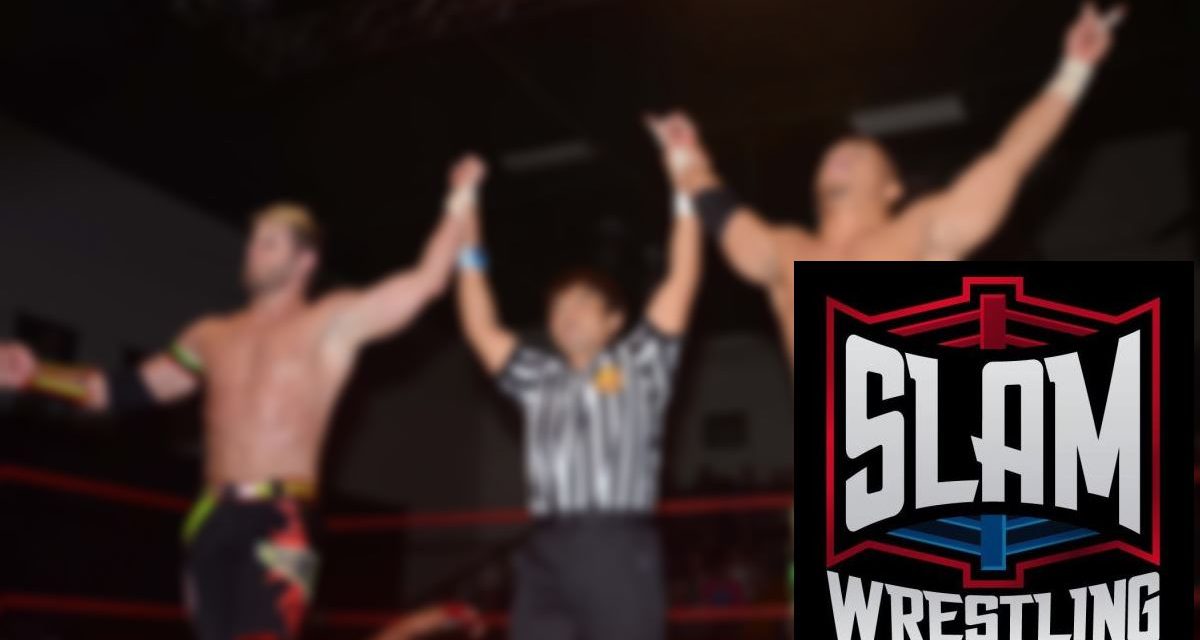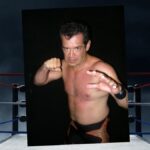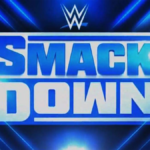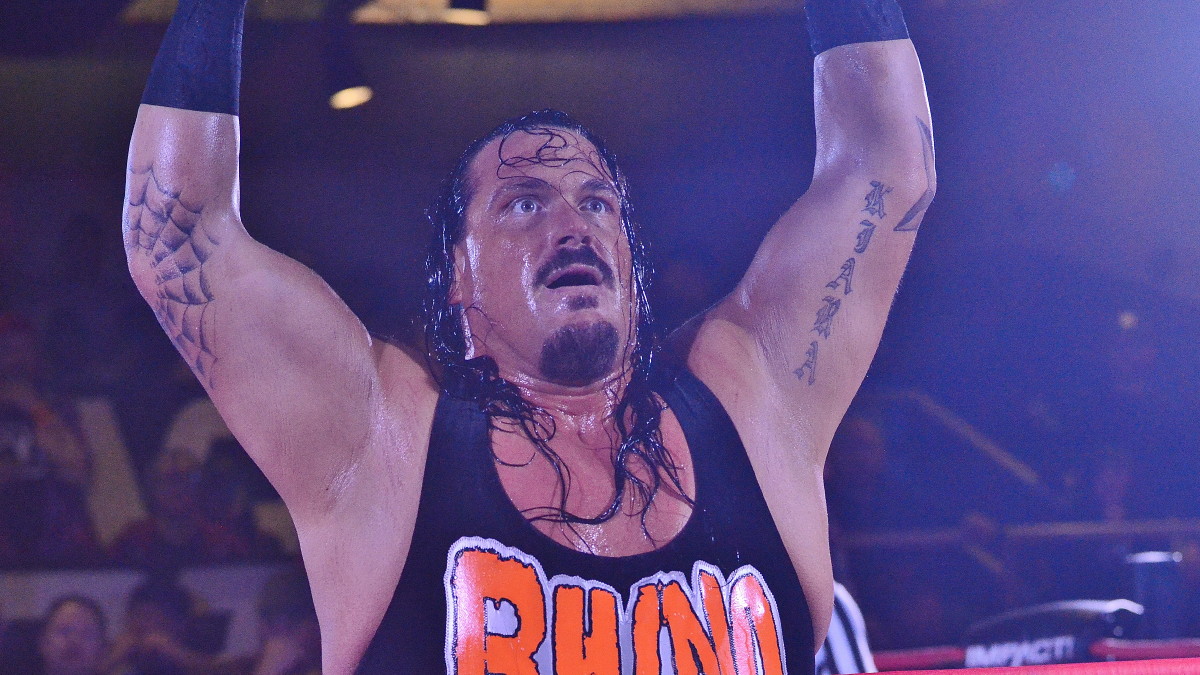Saturday nights in Georgia during the mid-1980s were memorable for wrestling fans and not just because of the weekly NWA cards held at The Omni. During a five-year stretch of Saturday nights, a beefy, wisecracking Atlantan named Joe Pedicino brought a weekly wrestling marathon into Georgia living rooms.
Beginning at 8 p.m. Saturday nights, Superstars of Wrestling — an extended block of programming that emanated out of Atlanta’s WATL-36 — brought action and drama from the nation’s territories to Georgia fans who, otherwise, would not have been able to view the regionally-specific programs.
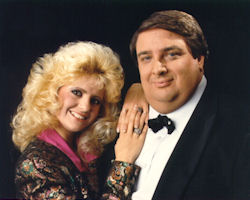
Boni Blackstone and Joe Pedicino.
If you lived in Georgia from 1986 to 1991 and owned a TV set capable of puling in a decent UHF signal, you were among those fortunate enough to view Superstars of Wrestling and its programming culled from an array of regional territories, as well as from international locales like Canada, Puerto Rico and Japan, stitched together with pre-taped segments from Pedicino and his co-host Boni Blackstone.
As Pedicino remembered, he was working as a retail sales rep for the station when Superstars of Wrestling began almost as a fluke.
“The program director there was unhappy because the wrestling show he was carrying, which was Memphis, wasn’t doing too good,” Pedicino recalled for SLAM! Wrestling. “I told him he was carrying the wrong show at the wrong time — 9 a.m. Saturday morning — which is when most wrestling fans were either still asleep or already up and out of the house. The show we were running was a great one, but there were some problems. First, instead of running a syndicated show, we were running whatever show Memphis sent the station. The whole show was about, ‘What I’m going to do to you Monday night?’ Then, when it came on the next week, other than maybe the main event, they didn’t really tell you what happened Monday night at the Coliseum.”
Soon, Pedicino had an idea to pitch — a wrestling show with a likable host that would capitalize on the prime, wide-open time slot that followed two hours of World Championship Wrestling on WTBS. No matter if it flopped or flew, Pedicino suggested that a more personalized wrestling telecast might at least help the small UHF station garner ratings higher than the non-existent “asterisks” earned by its Saturday night lineup of crusty B-movies.
“I said, ‘I want you to think about pro wrestling as a soap opera for men.’ Can you imagine a soap opera leading to a big, suspenseful ending each day and the next time you tune it back in they don’t even mention what happened last time? These wrestling fans were not finding out how their soap opera ended. When they asked me what I would do differently, I told them, up front, that I had an idea, but they weren’t going to do it. I said, ‘You know how Elvira comes in and hosts the midnight movie?’ Well, I wanted to do something like that with a wrestling show where the host came on and gave a rundown of what happened when we left off last Saturday. The second thing I suggested was move it to 8 o’clock Saturday night. At 7:45, the highest rated channel in the book was TBS, by far, which was airing Gordon Solie with two hours of wrestling. It was getting about a 9 share. I wanted to do a campaign that said ‘Hey, after watching two great hours of wrestling on TBS, tune in over here to WATL for another great hour of wrestling from Memphis.”
Superstars of Wrestling debuted in early 1986 as a two-hour program with Memphis and AWA television comprising its lineup. Fans who tuned into its seminal versions quickly learned that “wrestling” was much more than their local, home state promotion(s) and New York. Instead, it was a nationwide phenomenon that was growing hotter by the week. Within a few weeks on the air, Superstars of Wrestling had become the most watched program on WATL’s weekend schedule. Ultimately, it grew into an eight-hour wrestlefest that stretched until the wee hours of Sunday morning. Despite its “live” feel, Pedicino taped his segments throughout the preceding week. By Saturday, they had been edited together with featured TVs to create a show that often fooled fans into thinking they were missing out on a good time down at the WATL headquarters most Saturday nights.
“Joe put together a very interesting wrestling block, with himself and Boni Blackstone as the hosts throughout the evening. You could tell if you traveled Atlanta just how big this was becoming, because all over town, people were talking about all the different promotions that were on television,” said Paul Heyman, who had a regular “Danger Zone” segment during the block. “As much Atlanta being the home of WCW, then the NWA, cemented it as a wrestling capital, I think Joe Pedicino’s wrestling block on WATL was as impactful.”
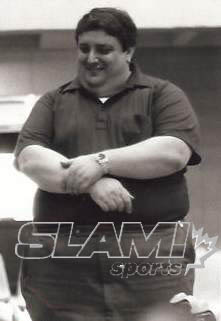
Joe Pedicino gets some fresh air during a Global Wrestling Federation taping in Dallas. Photo by Mike Lano, WReaLano@aol.com
The wrestling territory system of the day was the well from which Superstars drew its footage. Blasting into its 8 p.m. time slot with an opening montage of the Bonnie Tyler music video Holding Out For a Hero (hot off the big screen courtesy of Mad Max Beyond Thunderdome) mixed with snippets of bodyslams, headlocks and in-ring brawls, the wrestling block drew an immense amount of attention not just from local fans. There was also a laundry list of promotions eager to have their programming viewed by a wider audience.
Just by tuning into Superstars, fans were kept up to date on angles and storylines through weekly TVs provided by Southern territories in Alabama (Continental), Tennessee (CWA) and Georgia (the original Deep South promotion), as well as Bill Watts’ UWF/Mid-South, World Class Championship Wrestling out of Dallas and the bloody, riotous action of the WWC from Puerto Rico.
“For these territories, most of them were thrilled to be getting a phone call asking if they wanted to be broadcast in the Atlanta market on Saturday night in prime time. They were just tickled to death and would go out of their way to provide their programming. We were on all the cable stations in Atlanta and had a hell of an audience,” said Pedicino.
Part of the program’s appeal was its show-within-a-show format. Instead of simply stringing together hours of submitted tape each week, the business-suited Pedicino and his glittery co-host Boni Blackstone came off as sincere hosts who knew the product they presented and made an effort to get local fans in on the action. They regularly featured artwork and letters sent in by fans and also presented the Big Screw-Up Award each week to wrestlers who had performed the least admirably. Though the two bickered, pranked and wisecracked with one another on camera, co-hosts Blackstone and Pedicino fostered a romance that eventually saw the two wed. As Joe remembers, the brainy blonde’s inclusion on the show almost didn’t happen.
“I needed a co-host, somebody to play off. I wanted it to be a woman, but not a woman wrestler,” he recalled. “So, we came up with the idea to have an on-air contest to find a co-host. I figured we’d probably get a dozen or so entries. But, we actually got over 200! We had each entrant do two on-air segments with me for an hour. We made up a committee of seven people at the station to choose the winner. Boni was a blond bombshell with an attitude you wouldn’t believe and she was very knowledgeable about wrestling. Trust me, she did not have red light fever. In between the first and second take, I had to tell her, ‘Let me talk a little!’ Turns out, my producers all picked her to be the new co-host, but I didn’t think it was a good fit. She had a know-it-all attitude and I didn’t think we had a chance. They assured me, though, that we’d be great together.”
Pedicino was initially wary of his new co-host, but their partnership clicked within the two’s first couple of episodes together.
“Our first week, I realized we had to be like Sonny and Cher. I had to be the guy who thought he was in charge, and she had to be the cute little thing that everybody loved and somehow ended up getting her way. Well, it took off like crazy! She actually was the perfect co-host. Every guy out there wanted to date her and every mom out there wanted her little girl to grow up to be like Boni. She looked the part for the young guys, but acted the part for the mothers.”
Heyman compared the two hosts, saying that Pedicino’s sales background came through.
“Joe was the least likely personality to host a wrestling block, but he was so endearing to the audience, because he spoke from the perspective of a fan. It was just the fan who cheered the babyfaces and booed the heels, Joe liked exciting professional wrestling, and if it was good, he liked it. He was enthusiastic about it. If it was bad, he’d call the promotion on the carpet for it. He wasn’t just a blind hype-master,” he said. “Boni was just this super-hot, glamorous, sweet little pixie, Southern sex kitten, but at the same time, the girl next door.”
Blackstone really added to the block, said Heyman. “What Boni brought to the table was a very fun perspective on the personalities themselves. She knew how to talk about the heels with contempt and disdain, she knew how to describe the babyfaces as heroes with hope and carrying the hopes of the fans with them. Her enthusiasm, forgive the cliche, was quite contagious.”
During the peak of popularity for Superstars, Pedicino and Blackstone became as recognizable to Southern fans as many of the babyfaces and heels they presented each week. Surely, at that time, each of them had more name recognition in their Georgia homebase than a “rassler” from up north like Larry Zbyszko or Bob Backlund. Part of Pedicino’s instant fan cred came from his association with esteemed announcer Gordon Solie, who shared hosting duties with Pedicino on the syndicated evening news-style clip show Pro Wrestling This Week.
“They came to me and wanted to know if we could do something on Saturday mornings. We were airing six shows a night, so we just took a match out of all those shows and did Pro Wrestling This Week. It was filmed like a news show that also showed matches and gave updates on what was happening in wrestling. I’ll be damned if the son-of-a-bitch didn’t end up doing 4 and 5 ratings and was eventually syndicated. At one time, PWTW was syndicated in more markets than any other wrestling show except WWE.”
Superstars of Wrestling was also a launching pad for several persons who, in later years, would be mainstays in different facets of the wrestling business — Missy Hyatt, NWA Wildside’s Steven “DeTruth” Prazack and former WCW announcer Scott Hudson among them. One character who was able to sharpen his mic skills through appearances on “Superstars” — as well as with regional Georgia promotion Southern Championship Wrestling, which Pedicino helped run — was Heyman. Back then, the future ECW mastermind was sharpening the first draft of his psycho-yuppie alter ego Paul E. Dangerley (later Dangerously).
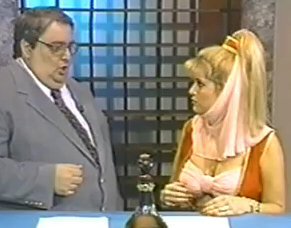
Joe Pedicino dreams of Jeanie, er, Boni. Photo courtesy Boni Blackstone.
“Being able to see wrestling from all over the nation and the world is so commonplace now that we take it for granted,” remembered Hudson, who started with Pedicino as a ring announcer, working for free. “Obviously, in the pre-Internet age, seeing weekly television from distant territories required a great deal of work via tape trading. Superstars of Wrestling allowed fans in Atlanta to see a world outside of just WCW and the WWF. It was really an eye-opening experience to see television from other territories and international promotions. During Pedicino’s run, he gave exposure to everyone. The legacy of the shows is that what we now take for granted, Joe Pedicino saw years ahead of its time. In many ways, Pedicino changed wrestling television in much the same way Vince McMahon changed wrestling.”
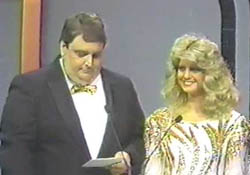
Pedicino and Blackstone in 1989. Courtesy Mike Lano, WReaLano@aol.com
Heyman first met Pedicino in New York at the Pro Wrestling Illustrated offices, when Pedicino was doing a segment on Captain Lou Albano. In that clip, Heyman interrupts Bill Apter’s interview with Albano.
Thanks to the magic of the Internet, the clip resurfaces occasionally on YouTube. “It’s quite embarrassing to me because I was so new to the business and had no idea what I was doing. Joe just gave me the freedom to go out there and do anything that I thought could get me over,” said Heyman, praising Pedicino for taking a chance on him.
“Joe gave me a monster break during my rookie year. Coming out of Memphis, when Austin Idol, Tommy Rich and I shaved Jerry Lawler’s head, and Joe offered me an interview segment, based on the popularity of Piper’s Pit, called The Danger Zone, because I was Paul E. Dangerously. I was heading to the AWA at the time, and I would shoot these Danger Zones either with AWA personalities or on my own, and Joe would air them unedited. Some of them were pretty racy for the day, and he didn’t care,” said Heyman. “He gave me tremendous creative freedom and spotlighted it so superbly — that’s a bad analogy, or a bad description, he, he gave the segment such a spotlight on the show and made it such a focal point of Pro Wrestling This Week that my brand recognition as Paul E. Dangerously just grew exponentially, because of not only the exposure that I was getting off of his show, but also because of how prominently he would build up the segment every week on his program.”
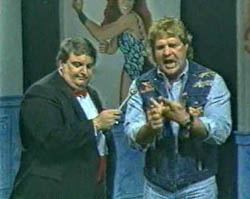
Joe Pedicino holds the microphone as Dick Slater rants. Courtesy Mike Lano, WReaLano@aol.com
As the ’80s gave way to the ’90s and the territories began to shut down, Superstars also began its decline. WATL became a Fox affiliate in 1988 and reluctantly parted ways with its homegrown wrestling showcase. “They gave us a shot at being on after 11 o’clock, which I thought was better than nothing,” said Pedicino. “But another Atlanta station, Channel 46, called up and said we could go there and still be on at 8 p.m. The program manager at Fox hated to do it, but he knew it was best for us.”
Pedicino and Blackstone eventually hosted abbreviated versions of Superstars on neighboring Channel 46 and, later, on upstart station Channel 14 out of Rome, GA. For a short time, Blackstone worked as an interviewer for the WWF, while Pedicino fought what turned out to be a losing business battle co-running the Global Wrestling Federation. Eventually, the wrestling life began to wear thin with both of them. As he remembers, Pedicino was juggling commentary obligations with a variety of promotions — namely Jim Crockett’s revived NWA out of Dallas — and the hectic travel schedule was getting tough to bear from week to week.
“At that point, Boni and I were married and we’d been doing this together for almost 10 years. We’d just gotten worn out. We were sitting on an airplane getting ready to fly back out to Dallas and Boni looked at me and said, ‘If you love me, we’ll get off this plane.’ So, we did. We called Jimmy Crockett and said we were sorry but we weren’t going to be there. We were out of it at that point. Between going here and there, to Texas each week and doing the LPWA women’s promotion, along with several others in Georgia, it had gotten to be too much.”
Today, Pedicino still lives in Georgia and, as he confirmed whole-heartedly, is still a wrestling fan. “I watch about everything that’s on,” he admitted. “Now, though, I watch it with a little bit more of an eye. I get a kick out of seeing what they’re doing and with whom.”
Pedicino and Blackstone get a chance to catch up with many old friends, as they will be co-hosting the NWA Wrestling Legends Fanfest this weekend in Atlanta.
The couple now resides in Newnan, and Pedicino’s early-in-life fascination with radio has come full circle, and they own FM country station 92.5 The Bear. In somewhat of an ironic twist for the couple who will always be associated with hosting Saturday televised wrestling during the ’80s and ’90s, wrestling now figures into their lives just Monday, Thursday and Friday nights — on TV, of course.
“I think one of the things I enjoy the most is when I see something new that I haven’t seen before,” Pedicino said. “I love what they’ve been doing with CM Punk lately. … That’s one of the things I enjoy the most is when I see something new that I haven’t seen before. It’s like, ‘Oh good, somebody’s thinking.”
— with files from Greg Oliver
RELATED LINK
